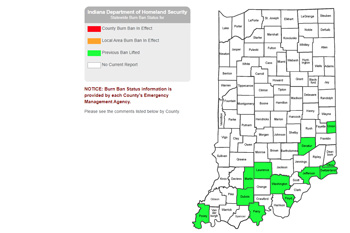Campfires
- Get Prepared
- Fire Safety
- Current: Campfires
The National Interagency Fire Center reports an average of more than 60,000 wildfires are caused by people every year, burning millions of acres. Campfires that toast marshmallows and hot dogs are a factor in this number. These sources of heat and light are a major part of backyard fun and camping trips, but taking a little time to practice safety will help make campfires safe for everyone.
Campfire Safety Tips
Quick Tips
- In some areas campfires are not permitted. Check with the local fire department and a campground’s visitor center before starting one. Also, know whether there is a burn ban in the county using the statewide burn ban map.
- Keep the fire in a contained unit such as a burn barrel, barbecue unit, hibachi or a small pit with rocks around it. Building a fire directly on the ground without barriers can allow the fire to spread underground through root systems or decaying material.
- Never leave a campfire unattended.
- In case of an emergency (like a sudden change in the weather), douse the fire. Even a small breeze could cause the fire to spread quickly.
- When extinguishing a fire, drown it with water and then stay away from it. The ash, coals and embers of fire sites can retain enough heat to cause severe burns for 12–24 hours.
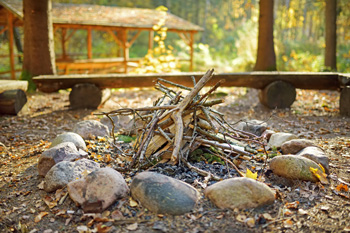
Before a Campfire
Planning ahead when camping can help limit the number of human-caused fires.
- Check the weather forecast. Weather fluctuations, such as sudden gusts of wind, could cause burning debris to spark a wildfire.
- In some areas campfires are not permitted. Check with the local fire department and the campground’s visitor center before starting one. Also, know whether there is a burn ban in the county using the statewide burn ban map.
- Safe burning sites are away from power lines, overhanging tree limbs, buildings, rotten stumps, shrubs and dry grass or leaves. The fire should have a vertical clearance at least three times the height of the wood pile, as heat from the fire extends far past the flames that are visible.
- Flammable objects such as tents and camping gear need to be at least 15 feet away from and upwind of the burn site.
- The ground around the fire or burn site should be surrounded by gravel or dirt for at least 10 feet in all directions. Keep the surrounding area watered down.
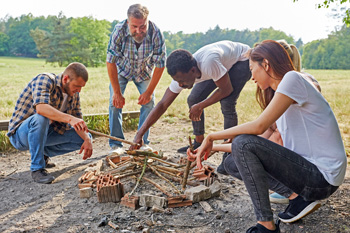
Building a Campfire
Below are safety guidelines to follow when building a fire.
- Start with dry twigs and small sticks. Add larger sticks as the fire grows. Add the largest pieces of wood last, pointing them toward the center of the fire and gradually pushing them into the flames.
- Keep the fire contained in a burn barrel, barbecue unit, hibachi or a small pit with rocks around it. Building a fire directly on the ground without barriers can allow the fire to spread underground through root systems or decaying material.
- Never use gasoline, diesel fuel, lighter fluid and other dangerous fuels to ignite or keep the fire burning.
- After lighting the fire, do not discard the match until it is cold. Douse it with water to be sure.
- Keep campfires small and do not let them get out of hand. The suggested size is no more than two feet tall and wide.
- Stack extra firewood upwind and away from the fire so wind will not accidentally blow sparks onto the additional wood.
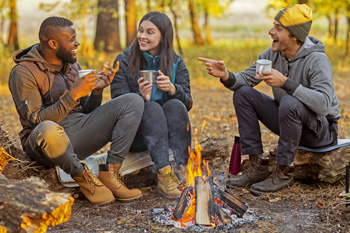
During a Campfire
Campfires need constant supervision to remain under control. Follow these tips and always stay diligent.
- Never allow children or pets near the fire. Do not leave them unsupervised.
- Teach kids how to stop, drop and roll if clothing catches fire. Have a fire extinguisher on hand for emergencies and teach children how to use it.
- If in an area where drinking alcoholic beverages is permitted, do not throw the empty containers into the fire. Also, designate people who will remain sober to maintain the fire, call for help in case of emergencies and watch the group for safety.
- Never leave a campfire unattended. In the event of an emergency, such as a sudden change in the weather, douse the fire. Even a small breeze can cause the fire to spread quickly.
- In the event of a burn, immediately place cool water on the skin for three to five minutes, and wrap the area in a clean, dry cloth. Call medical personnel if a burn is severe.
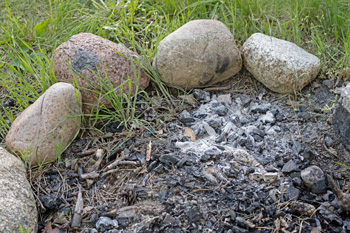
Extinguishing a Campfire
Properly extinguishing a campfire is important for safety. Many of the campfire burns children receive stem from day-old fire sites that are still hot.
- When extinguishing the fire, drown it with water. Make sure all embers, coals and sticks are wet. If you do not have water, use dirt. Mix plenty of soil and sand with the embers. Continue adding and stirring until all material is cooled.
- Keep plenty of water nearby and have a shovel for throwing sand on the fire if it gets out of control.
- For uncontrolled fires, immediately call 911, the nearest park ranger or the campground host. Provide information about the location so the fire can quickly be found.
- Do not bury used charcoal briquettes or hot coals. These can smolder and start to burn again.

